Kunlun Xu
STOP: Integrated Spatial-Temporal Dynamic Prompting for Video Understanding
Mar 20, 2025Abstract:Pre-trained on tremendous image-text pairs, vision-language models like CLIP have demonstrated promising zero-shot generalization across numerous image-based tasks. However, extending these capabilities to video tasks remains challenging due to limited labeled video data and high training costs. Recent video prompting methods attempt to adapt CLIP for video tasks by introducing learnable prompts, but they typically rely on a single static prompt for all video sequences, overlooking the diverse temporal dynamics and spatial variations that exist across frames. This limitation significantly hinders the model's ability to capture essential temporal information for effective video understanding. To address this, we propose an integrated Spatial-TempOral dynamic Prompting (STOP) model which consists of two complementary modules, the intra-frame spatial prompting and inter-frame temporal prompting. Our intra-frame spatial prompts are designed to adaptively highlight discriminative regions within each frame by leveraging intra-frame attention and temporal variation, allowing the model to focus on areas with substantial temporal dynamics and capture fine-grained spatial details. Additionally, to highlight the varying importance of frames for video understanding, we further introduce inter-frame temporal prompts, dynamically inserting prompts between frames with high temporal variance as measured by frame similarity. This enables the model to prioritize key frames and enhances its capacity to understand temporal dependencies across sequences. Extensive experiments on various video benchmarks demonstrate that STOP consistently achieves superior performance against state-of-the-art methods. The code is available at https://github.com/zhoujiahuan1991/CVPR2025-STOP.
SCAP: Transductive Test-Time Adaptation via Supportive Clique-based Attribute Prompting
Mar 17, 2025Abstract:Vision-language models (VLMs) encounter considerable challenges when adapting to domain shifts stemming from changes in data distribution. Test-time adaptation (TTA) has emerged as a promising approach to enhance VLM performance under such conditions. In practice, test data often arrives in batches, leading to increasing interest in the transductive TTA setting. However, existing TTA methods primarily focus on individual test samples, overlooking crucial cross-sample correlations within a batch. While recent ViT-based TTA methods have introduced batch-level adaptation, they remain suboptimal for VLMs due to inadequate integration of the text modality. To address these limitations, we propose a novel transductive TTA framework, Supportive Clique-based Attribute Prompting (SCAP), which effectively combines visual and textual information to enhance adaptation by generating fine-grained attribute prompts across test batches. SCAP first forms supportive cliques of test samples in an unsupervised manner based on visual similarity and learns an attribute prompt for each clique, capturing shared attributes critical for adaptation. For each test sample, SCAP aggregates attribute prompts from its associated cliques, providing enriched contextual information. To ensure adaptability over time, we incorporate a retention module that dynamically updates attribute prompts and their associated attributes as new data arrives. Comprehensive experiments across multiple benchmarks demonstrate that SCAP outperforms existing state-of-the-art methods, significantly advancing VLM generalization under domain shifts. Our code is available at https://github.com/zhoujiahuan1991/CVPR2025-SCAP.
DASK: Distribution Rehearsing via Adaptive Style Kernel Learning for Exemplar-Free Lifelong Person Re-Identification
Dec 12, 2024Abstract:Lifelong person re-identification (LReID) is an important but challenging task that suffers from catastrophic forgetting due to significant domain gaps between training steps. Existing LReID approaches typically rely on data replay and knowledge distillation to mitigate this issue. However, data replay methods compromise data privacy by storing historical exemplars, while knowledge distillation methods suffer from limited performance due to the cumulative forgetting of undistilled knowledge. To overcome these challenges, we propose a novel paradigm that models and rehearses the distribution of the old domains to enhance knowledge consolidation during the new data learning, possessing a strong anti-forgetting capacity without storing any exemplars. Specifically, we introduce an exemplar-free LReID method called Distribution Rehearsing via Adaptive Style Kernel Learning (DASK). DASK includes a Distribution Rehearser Learning mechanism that learns to transform arbitrary distribution data into the current data style at each learning step. To enhance the style transfer capacity of DRL, an Adaptive Kernel Prediction network is explored to achieve an instance-specific distribution adjustment. Additionally, we design a Distribution Rehearsing-driven LReID Training module, which rehearses old distribution based on the new data via the old AKPNet model, achieving effective new-old knowledge accumulation under a joint knowledge consolidation scheme. Experimental results show our DASK outperforms the existing methods by 3.6%-6.8% and 4.5%-6.5% on anti-forgetting and generalization capacity, respectively. Our code is available at https://github.com/zhoujiahuan1991/AAAI2025-DASK
Deep Learning Techniques for Automatic Lateral X-ray Cephalometric Landmark Detection: Is the Problem Solved?
Sep 24, 2024Abstract:Localization of the craniofacial landmarks from lateral cephalograms is a fundamental task in cephalometric analysis. The automation of the corresponding tasks has thus been the subject of intense research over the past decades. In this paper, we introduce the "Cephalometric Landmark Detection (CL-Detection)" dataset, which is the largest publicly available and comprehensive dataset for cephalometric landmark detection. This multi-center and multi-vendor dataset includes 600 lateral X-ray images with 38 landmarks acquired with different equipment from three medical centers. The overarching objective of this paper is to measure how far state-of-the-art deep learning methods can go for cephalometric landmark detection. Following the 2023 MICCAI CL-Detection Challenge, we report the results of the top ten research groups using deep learning methods. Results show that the best methods closely approximate the expert analysis, achieving a mean detection rate of 75.719% and a mean radial error of 1.518 mm. While there is room for improvement, these findings undeniably open the door to highly accurate and fully automatic location of craniofacial landmarks. We also identify scenarios for which deep learning methods are still failing. Both the dataset and detailed results are publicly available online, while the platform will remain open for the community to benchmark future algorithm developments at https://cl-detection2023.grand-challenge.org/.
Category-Aware Transformer Network for Better Human-Object Interaction Detection
Apr 11, 2022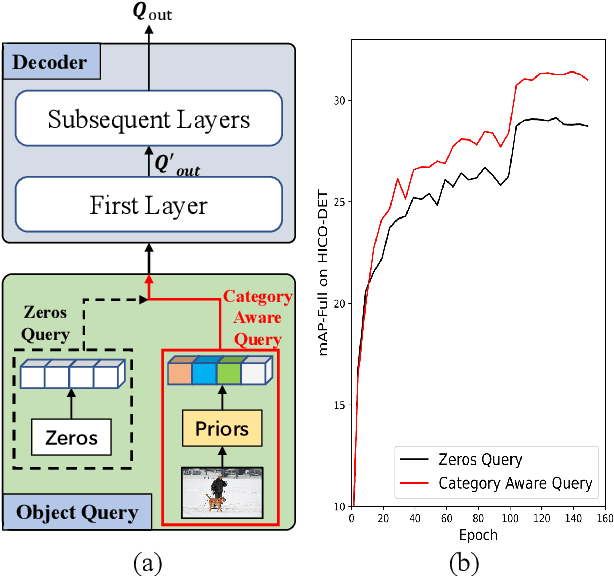

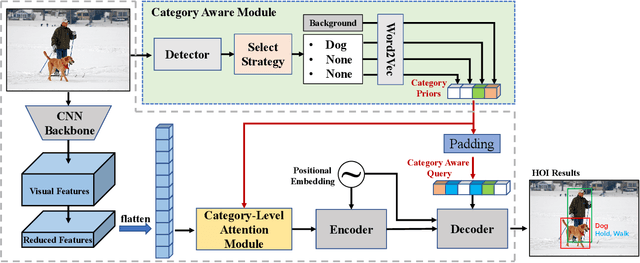
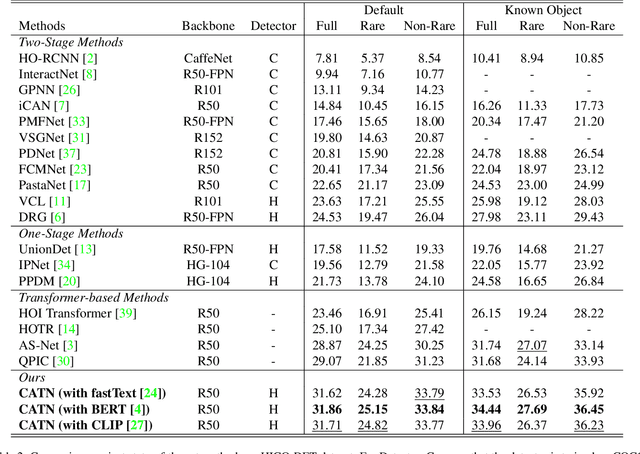
Abstract:Human-Object Interactions (HOI) detection, which aims to localize a human and a relevant object while recognizing their interaction, is crucial for understanding a still image. Recently, transformer-based models have significantly advanced the progress of HOI detection. However, the capability of these models has not been fully explored since the Object Query of the model is always simply initialized as just zeros, which would affect the performance. In this paper, we try to study the issue of promoting transformer-based HOI detectors by initializing the Object Query with category-aware semantic information. To this end, we innovatively propose the Category-Aware Transformer Network (CATN). Specifically, the Object Query would be initialized via category priors represented by an external object detection model to yield better performance. Moreover, such category priors can be further used for enhancing the representation ability of features via the attention mechanism. We have firstly verified our idea via the Oracle experiment by initializing the Object Query with the groundtruth category information. And then extensive experiments have been conducted to show that a HOI detection model equipped with our idea outperforms the baseline by a large margin to achieve a new state-of-the-art result.
Effective Actor-centric Human-object Interaction Detection
Feb 24, 2022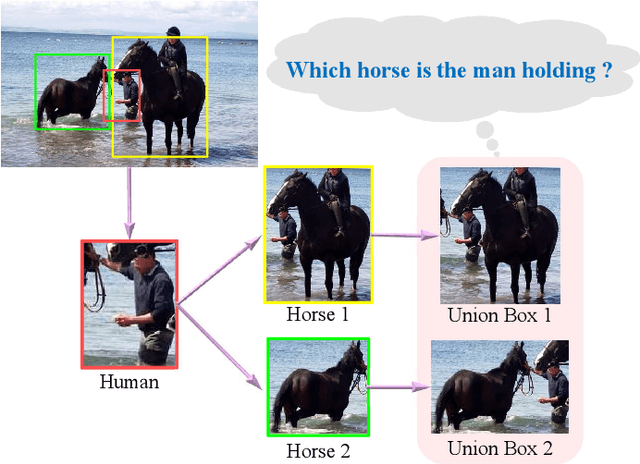
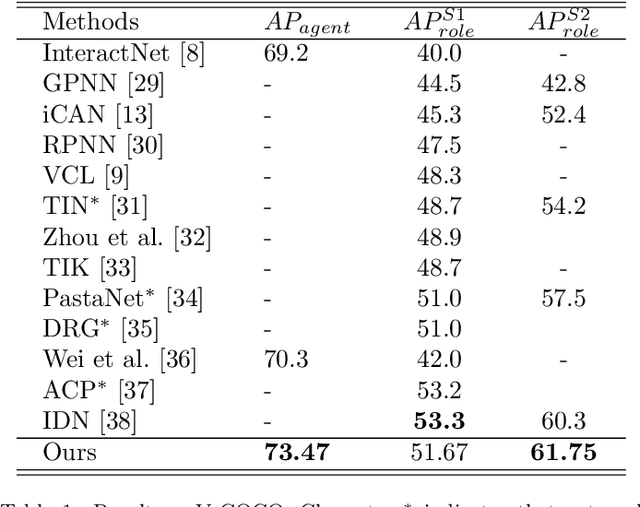
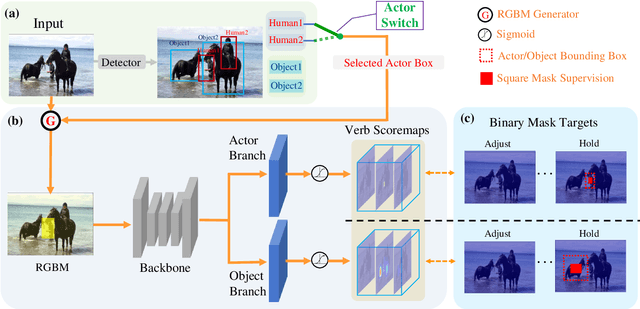
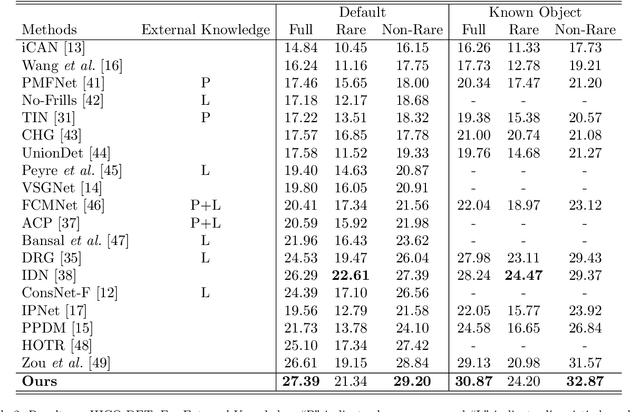
Abstract:While Human-Object Interaction(HOI) Detection has achieved tremendous advances in recent, it still remains challenging due to complex interactions with multiple humans and objects occurring in images, which would inevitably lead to ambiguities. Most existing methods either generate all human-object pair candidates and infer their relationships by cropped local features successively in a two-stage manner, or directly predict interaction points in a one-stage procedure. However, the lack of spatial configurations or reasoning steps of two- or one- stage methods respectively limits their performance in such complex scenes. To avoid this ambiguity, we propose a novel actor-centric framework. The main ideas are that when inferring interactions: 1) the non-local features of the entire image guided by actor position are obtained to model the relationship between the actor and context, and then 2) we use an object branch to generate pixel-wise interaction area prediction, where the interaction area denotes the object central area. Moreover, we also use an actor branch to get interaction prediction of the actor and propose a novel composition strategy based on center-point indexing to generate the final HOI prediction. Thanks to the usage of the non-local features and the partly-coupled property of the human-objects composition strategy, our proposed framework can detect HOI more accurately especially for complex images. Extensive experimental results show that our method achieves the state-of-the-art on the challenging V-COCO and HICO-DET benchmarks and is more robust especially in multiple persons and/or objects scenes.
 Add to Chrome
Add to Chrome Add to Firefox
Add to Firefox Add to Edge
Add to Edge